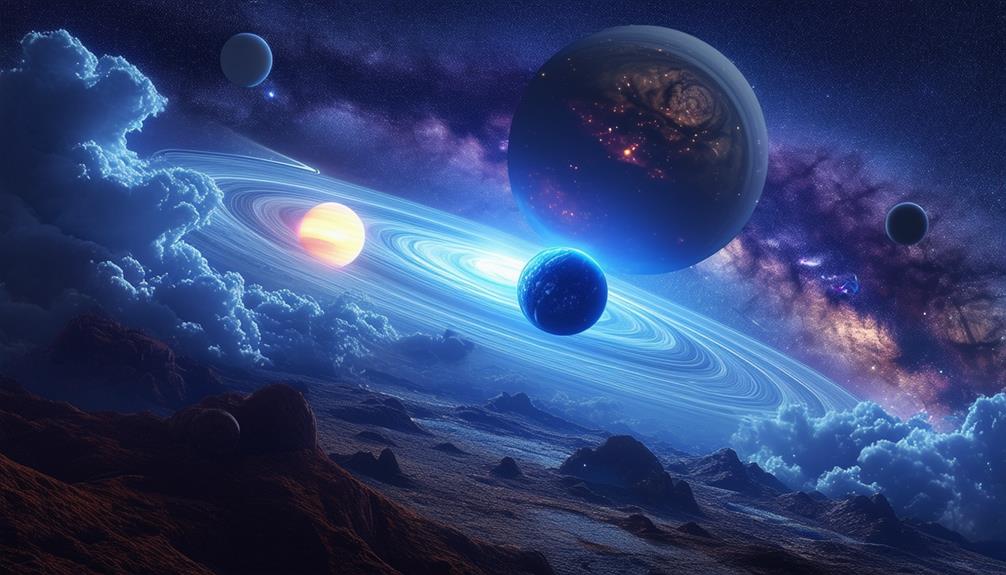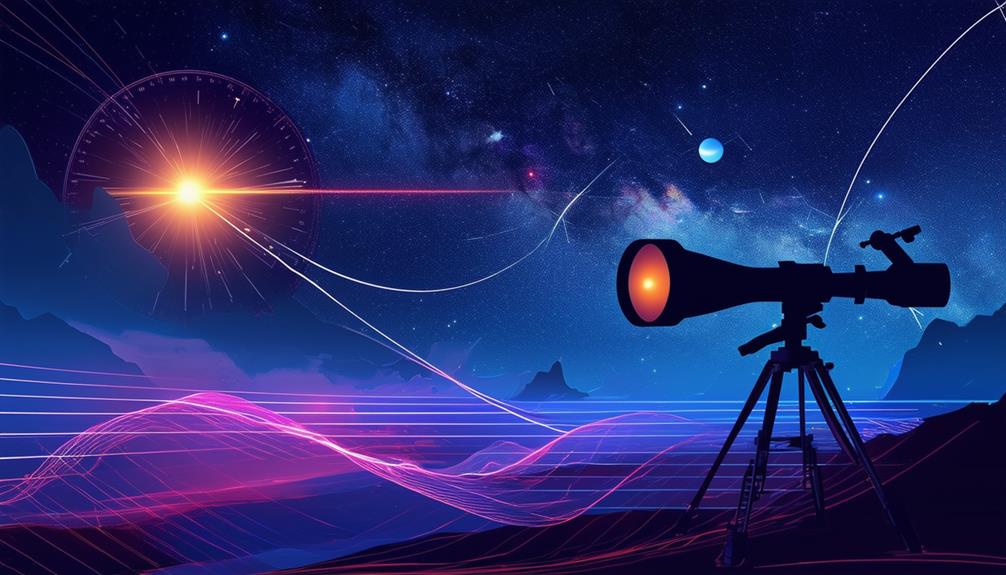The Discovery and Significance of Exoplanets

Exploring the discovery of exoplanets opens a gateway to a field that has fundamentally transformed our comprehension of the cosmos. These planets, which orbit stars outside our Solar System, span a diverse range from colossal gas giants to rocky worlds with potential for life.
Since the first confirmed exoplanet, 51 Pegasi b, was discovered in 1995, the techniques for detecting these distant planets have advanced significantly. But why are these discoveries so crucial? With over 5,000 exoplanets identified, the ramifications for our understanding of planetary systems and the possibility of extraterrestrial life are immense.
What Are Exoplanets?
Exoplanets are planets that exist outside our Solar System, orbiting stars other than the Sun. Astronomers have discovered thousands of these celestial bodies, with over 5,000 identified to date, indicating that most stars in our galaxy likely host at least one planet.
The study of exoplanets reveals a remarkable diversity in their composition. Some are massive gas giants similar to Jupiter and Saturn, while others are rocky or icy worlds akin to Earth and Neptune. This diversity challenges our understanding of planetary systems and prompts us to rethink how planets form and evolve.
Among the discovered exoplanets, a few are considered potentially habitable. These planets have conditions that might support life, such as suitable temperatures and the presence of water.
The search for habitable exoplanets aims to find environments where life could exist beyond Earth, expanding our understanding of life's potential in the universe.
Methods of Discovery
Scientists have developed several fascinating methods to discover exoplanets. The radial velocity method detects a star's wobble caused by the gravitational pull of an orbiting planet.
The transit method identifies planets by observing the periodic dimming of a star's light as a planet passes in front of it. Direct imaging, though challenging, involves capturing actual images of these distant worlds.
Radial Velocity Method
The radial velocity method detects exoplanets by measuring the wobble of a star caused by the gravitational pull of orbiting planets. This technique has been crucial in discovering numerous exoplanets, starting with 51 Pegasi b in 1995. When a planet influences its star gravitationally, it induces periodic velocity shifts in the star, detectable through precise measurements.
The method is particularly effective for identifying massive planets close to their stars. By analyzing the star's periodic movements, scientists can determine the exoplanet's minimum mass and estimate its orbital characteristics. This information is essential for understanding the dynamics of exoplanetary systems and the distribution of planets within our galaxy.
Here's a concise overview:
| Key Concept | Description |
|---|---|
| Radial Velocity Method | Detects exoplanets by measuring star wobble |
| Initial Exoplanet Identified | 51 Pegasi b in 1995 |
| Data Revealed | Minimum mass, orbital characteristics |
| Importance | Aids in understanding exoplanetary dynamics and planet distribution |
Grasping these principles provides valuable insight into how astronomers study distant worlds.
Transit Method Effectiveness
The transit method is a highly effective technique for discovering exoplanets by observing the slight dimming of a star's light when a planet transits in front of it. This method has proven extremely successful, particularly with NASA's Kepler mission, which identified thousands of exoplanets by monitoring changes in star brightness caused by these transits.
By analyzing transit data, researchers can determine crucial details about exoplanets, such as their size, orbital period, and distance from their host star. This information is vital for identifying Earth-sized planets located in the habitable zone, where conditions might support liquid water and, consequently, life.
The transit method allows scientists to gather essential insights into the characteristics and diversity of exoplanets, significantly advancing our understanding of planetary systems beyond our own. Its effectiveness has broadened our knowledge and paved the way for future human exploration.
Direct Imaging Challenges
Directly imaging exoplanets poses significant challenges due to the intense glare from their host stars, which can be millions of times brighter than the exoplanets' reflected light. To address this, scientists utilize advanced instruments such as coronagraphs and starshades. These tools effectively block out the overwhelming starlight, enabling telescopes to capture the faint light emitted or reflected by the exoplanets.
The primary advantage of direct imaging lies in its capability to study exoplanetary atmospheres and assess potential habitability. By analyzing the spectrum of light from these planets, researchers can determine various properties, including temperature, atmospheric composition, and potential biosignatures indicative of life. Despite the technical difficulties, direct imaging yields crucial insights into the diversity and characteristics of exoplanetary systems.
| Specialized Tool | Function |
|---|---|
| Coronagraphs | Block starlight to reveal exoplanets |
| Starshades | Work with telescopes to block starlight |
| Analysis Capability | Benefit |
| Atmospheric Composition | Identifies potential signs of life |
| Temperature Measurement | Assesses habitability |
Early Discoveries

The first confirmed exoplanet detection occurred in 1992 around the pulsar PSR B1257+12. Pioneers like Michel Mayor and Didier Queloz later made significant discoveries, including 51 Pegasi b in 1995.
Historical claims and theories dating back to the 16th and 19th centuries also speculated about the existence of such distant worlds.
First Exoplanet Detection
In 1992, astronomers made history by confirming the first detection of exoplanets around the pulsar PSR B1257+12. This groundbreaking discovery marked the first confirmed detection of planets outside our solar system. The exoplanet system included three planets named Draugr, Poltergeist, and Phobetor. These planets orbit a pulsar, a highly magnetized, rotating neutron star that emits beams of electromagnetic radiation.
The finding was monumental because it demonstrated that planets could form and exist in environments vastly different from those around Sun-like stars. The planets in this system were detected through precise measurements of the pulsar's timing variations, which indicated the gravitational influence of orbiting bodies. Draugr, Poltergeist, and Phobetor were found to be roughly the size of terrestrial planets, offering a completely new perspective on where planets might be found and how they could form.
While the detection of 51 Pegasi b in 1995 marked the first detection of an exoplanet orbiting a Sun-like star, the 1992 discovery around PSR B1257+12 opened the floodgates for the field of exoplanetary science. It revealed that the universe was far more diverse and wondrous than previously imagined.
Historic Claims Validated
Early stargazers, such as Giordano Bruno and Isaac Newton, laid the groundwork for the eventual validation of exoplanets with their innovative theories. Although their early assertions were speculative, they were pivotal in setting the stage for future discoveries. For instance, astronomers William Jacob and Thomas See made early observations about planetary orbits that suggested the existence of exoplanets.
The first solid evidence of an exoplanet came in 1992, when astronomers discovered planets orbiting the pulsar PSR B1257+12. These were among the earliest confirmed exoplanets. In 1995, Michel Mayor and Didier Queloz made a groundbreaking discovery with 51 Pegasi b, the first exoplanet detected around a Sun-like star. This exoplanet, often referred to as Pegasi b, revolutionized our understanding of planetary systems beyond our own.
Interestingly, there was potential evidence of an exoplanet near a white dwarf star as early as 1917, highlighting the long history of exoplanet exploration.
Key Milestones:
| Year | Discovery |
|---|---|
| 1917 | Potential evidence of an exoplanet near a white dwarf |
| 1992 | Discovery of exoplanets around PSR B1257+12 |
| 1995 | Michel Mayor and Didier Queloz discover 51 Pegasi b |
| 2002 | Confirmation of Gamma Cephei b |
These milestones underscore the transition from early theoretical predictions to concrete evidence, validating historical assertions about the existence of exoplanets.
Pioneering Discoveries Analyzed
Building on the validation of historic claims, groundbreaking advancements like the detection of planets around PSR B1257+12 and 51 Pegasi b have reshaped our understanding of the cosmos. These pioneering breakthroughs paved the way for a new age in astronomy, transforming theories into tangible findings.
Long before these milestones, Giordano Bruno proposed the existence of exoplanets in the 16th century, a radical idea later supported by Isaac Newton. Despite the skepticism of their times, early astronomers like William Jacob and Thomas See made bold claims about exoplanet findings in the late 19th century. Although their assertions lacked the technological backing, they set the stage for future advancements.
The first confirmed identification of exoplanets came in 1992 when astronomers discovered planets orbiting the pulsar PSR B1257+12. This breakthrough demonstrated that planets could exist in extreme environments.
Then, in 1995, Michel Mayor and Didier Queloz uncovered 51 Pegasi b, the first exoplanet found orbiting a Sun-like star, solidifying the field of exoplanet research.
Interestingly, evidence of a potential exoplanet near a white dwarf star was found as early as 1917, suggesting that the search for exoplanets has deeper historical roots than often recognized.
Recent Breakthroughs
Recent breakthroughs in exoplanet exploration have unveiled a remarkable variety of new worlds, significantly expanding our comprehension of the cosmos. For instance, the initial direct identification of a known exoplanet has yielded invaluable data, allowing scientists to study these distant worlds in unprecedented detail.
Researchers have discovered lava worlds with molten surfaces and water worlds abundant in liquid oceans, suggesting diverse planetary compositions and interactions with their stars. These discoveries challenge our previous assumptions about planetary systems, revealing environments that range from scorching hot to icy cold.
As of July 1, 2024, there are 6,660 confirmed exoplanets in 4,868 planetary systems, with nearly 1,000 of these systems featuring multiple planets. This prevalence of multi-planet systems indicates a rich diversity in planetary formation and evolution.
Ongoing research continues to uncover new exoplanets, analyzing their unique characteristics and behaviors. Each discovery brings us closer to understanding the vast, intricate tapestry of our universe, making every new finding a crucial piece of the cosmic puzzle.
Significance of Exoplanet Studies

Exoplanet studies are crucial in the quest to determine if life exists beyond Earth. By exploring habitable exoplanets, scientists gain insights into the conditions that make a planet capable of supporting life. These investigations aren't only about discovering new worlds but also about understanding the complex processes of planet formation and evolution. Each discovery contributes to our knowledge of planetary diversity, highlighting the variety of planets beyond our Solar System.
Studying exoplanets involves searching for life and challenging traditional views of planetary systems, thereby broadening our comprehension of the Universe. By examining the habitability of exoplanets, researchers investigate the conditions that could support life on other planets. This is essential in identifying potential life-hosting worlds, guiding scientists toward planets with the right conditions for life.
The significance of exoplanet studies goes beyond mere curiosity. They're pivotal in the search for habitable exoplanets and extraterrestrial life. Each discovery brings us one step closer to understanding whether we're alone in the Universe.
Search for Earth-like Planets
In the quest for Earth-like planets, scientists focus on finding worlds with conditions suitable for liquid water and a habitable atmosphere, as these are essential for life as we know it. The habitable zone, often called the 'Goldilocks zone,' is the region around a star where temperatures allow liquid water to exist.
Locating Earth-like exoplanets is complex. Among the thousands of exoplanets discovered, only a few are deemed potentially habitable. These planets must possess the right conditions, including a stable atmosphere, to support life. Scientists use various methods, such as analyzing starlight and observing planetary wobbles, to identify these rare candidates.
The ultimate aim is to find a world that could potentially host life beyond Earth. Ongoing research and technological advancements are enhancing our ability to discover such planets. By identifying potentially habitable exoplanets, we move closer to answering one of humanity's most profound questions: Are we alone in the universe? Each new finding broadens our understanding of what makes a planet capable of supporting life.
Conclusion
The discovery of exoplanets has revolutionized our understanding of the universe. With continuous advancements in detection methods and frequent breakthroughs, the study of these distant worlds grows more thrilling.
By examining exoplanets, we not only uncover their vast diversity but also inch closer to answering one of humanity's most profound questions: Are we alone in the cosmos?
Stay curious; the next major discovery might be imminent.




